Overview
- Title
- Wesen des Judentums
- Series Title
- Schriften herausgegeben von der Gesellschaft zur Förderung der Wissenschaft des Judentums.
- Date
-
publication/distribution:
1960
- Geography
-
publication:
Cologne (Germany)
- Credit Line
- United States Holocaust Memorial Museum Collection
- Contributor
-
Author:
Leo Baeck
Publisher: Joseph Melzer Verlag
- Biography
-
Leo Baeck was born on May 23 1873 in Lissa, Germany (now Leszno Poland), to Samuel Baeck and Eva Placzek Baeck. His father was a Rabbi and Leo was raised in a traditional home, observing dietary laws and studying the Talmud daily. Leo had 4 sisters. He attended Jewish Theological Seminary in Breslau and served as a rabbi, and a scholar on the Jewish faith. In 1899 he married Natalie Hamburger. They had a daughter, Ruth on August 22 1900. In 1912 Baeck went to Berlin where he worked as a Rabbi and lectured at the Hochschule für die Wissenschaft des Judentums. During World War I he served as a Champlain in the German army. After the war Baeck would become a prominent leader in the German Jewish community. He returned to Berlin and became President of the Union of German Rabbis and he was elected President of the German B’nai B’rith Order in 1924.
After Hitler seized power of the German Government in 1933, laws were passed that restricted Jewish life. In 1933 Leo Baeck was elected president of the Reichsvertretung der deutschen Juden, an organization of Jewish groups whose goal was to advance the interests of German Jewry in the face of Nazi oppression. In September 1935, the Nazis announced the Nuremberg Laws which excluded Jews from citizenship and prohibited them from marrying or having sexual relations with persons of German blood. The laws defined a Jew as a person who had 3 or more grandparents that were Jews, regardless of their religious practice. With the increasing German antisemitism, Baeck received many offers of emigration, but he refused to leave his community, even after Jewish businesses and synagogues were burned and looted in November 1938. Baeck remained president of the Reichsvertretung der deutschen Juden until 1943 when it was placed under the state’s control and renamed Reichsvereinigung der Juden in Deutschland and then disbanded later in the year.
Baeck was sent to Theresienstadt (Terezin) ghetto labor camp in occupied Czechoslovakia. There he gave lectures on philosophy and religion and became a leader of the camp’s Jews. The camp was liberated in May 1945. All 4 of Baeck’s sisters were murdered at Theresienstadt. Germany surrendered May 7, 1945 and Baeck went to England where his daughter Ruth lived. Leo Baeck, age 83, died on November 2, 1956 in London.
Physical Details
- Language
- German
- Classification
-
Books and Published Materials
- Category
-
Books and pamphlets
- Object Type
-
Books (lcsh)
- Materials
- overall : paper, ink
Rights & Restrictions
- Conditions on Access
- No restrictions on access
- Conditions on Use
- No restrictions on use
Keywords & Subjects
- Topical Term
- Judaism.
Administrative Notes
- Legal Status
- Permanent Collection
- Provenance
- The book was acquired by the United States Holocaust Memorial Museum in 2004.
- Record last modified:
- 2022-07-28 18:11:19
- This page:
- https://collections.ushmm.org/search/catalog/irn517888
Download & Licensing
In-Person Research
- By Appointment
- Request 21 Days in Advance of Visit
- Plan a Research Visit
- Request to See This Object
Contact Us
Also in Luneberg, Germany, and Theresienstadt ghetto/labor camp documents and realia collection
The collection consists of artifacts, correspondence, documents, negatives, photographs, and publications relating to the history of the Holocaust in German occupied Czechoslovakia and Nazi Germany.
Date: approximately 1939-approximately 1945
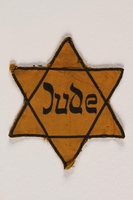
Star of David yellow cloth badge printed with Jude, the German word for Jew
Object
Star of David yellow cloth badge with the German word, Jude, for Jew, worn in Lüneburg (alternate spelling Lueneberg), Germany. In September 1941, the Nazi government ordered all Jews over the age of 6 to wear a badge with a Judenstern [Jewish star] on their outer clothing at all times to mark them as outcasts from German society and to make them easy to identify. In most places, the Jews were responsible for the manufacture and distribution of the badges. This type was printed on rolls of cloth with dotted cutting guidelines and cut off as needed. .
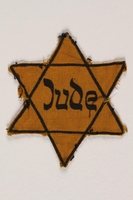
Star of David yellow cloth badge printed with Jude, the German word for Jew
Object
Star of David yellow cloth badge with the German word, Jude, for Jew, worn in Lüneburg (alternate spelling Lueneberg), Germany. In September 1941, the Nazi government ordered all Jews over the age of 6 to wear a badge with a Judenstern [Jewish star] on their outer clothing at all times to mark them as outcasts from German society and to make them easy to identify. In most places, the Jews were responsible for the manufacture and distribution of the badges. This type was printed on rolls of cloth with dotted cutting guidelines and cut off as needed.
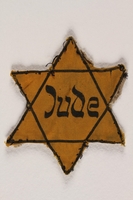
Star of David yellow cloth badge printed with Jude, the German word for Jew
Object
Star of David yellow cloth badge with the German word, Jude, for Jew, worn in Lüneburg, Germany. In September 1941, the Nazi government ordered all Jews over the age of 6 to wear a badge with a Judenstern [Jewish star] on their outer clothing at all times to mark them as outcasts from German society and to make them easy to identify. In most places, the Jews were responsible for the manufacture and distribution of the badges. This type was printed on rolls of cloth with dotted cutting guidelines and cut off as needed. They were printed with dotted guidelines as aids for cutting one out neatly.
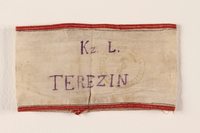
Handmade white armband stamped for medical personnel worn by an inmate in Theresienstadt
Object
Handmade white cloth armband presumably worn by an inmate at Theresienstadt ghetto/labor camp. It has a medical stamp and KZ. L Terezin handwritten on the center. The camp was run by the German SS but a Jewish Council of Elders organized municipal services, such as a health care system run by imprisoned doctors and nurses. Theresienstadt existed from November 24, 1941, until May 9, 1945, in the German controlled Protectorate of Bohemia and Moravia in the former Czechoslovakia. Terezin operated as a transit camp and and ghetto/labor camp for Jews deported from the Greater German Reich. It was expected that many would die due to the poor conditions. Approximately 140,000 Jews were transported to Terezin: 90,000 were deported to almost certain death in the east beginning in early 1942. Around 33,000 prisoners died in Theresienstadt. The International Red Cross took over administration of the camp on May 2, 1945. The German commandant and guards fled on May 5 and 6 as the Soviet Army neared the camp.
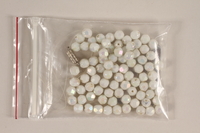
Opaque glass bead necklace found at Lüneburg
Object
Broken necklace found in Lüneburg, Germany, after the war. During the Nazi dictatorship, from October 1941 - spring 1945, the Lüneburg State Institute operated a special children's ward that participated in the euthanasia program to secretly kill mentally and physically disabled children. At least 300 children were murdered at Lüneburg by lethal overdose or starvation. The methods and implementation of the child-killing policy were left to each hospital. The policy was issued by the Office of the Fuhrer as part of the plan to create a master race and to cleanse the German population of genetically diseased persons.

Christmas gift box for Haeberlein-Metzger Nuremberg lebkuchen
Object
Haeberlein-Metzger Nuremberg lebkuchen packaging chest decorated with colorful images of gingerbread people, Christmas angels and ornaments. Lebkuchen is a biscuit similar to gingerbread cookies traditionally baked as a Christmas treat. It has been associated with Nuremberg since the 14th century and a variation known as Nuremberg Lebkuchen by law can only be produced in that city. The boxes and tins are often collected. This version was produced circa 1945 during the Nazi era in Germany.
Hinsel family papers
Document
The Hinsel family papers consist of biographical materials, correspondence, photographs, printed materials, and World War I diaries documenting the Hinsel family in Lüneburg, their relatives in Lüneburg and Hamburg, Hinsel and Leandrin family members’ military service during World War I, and Christine Hinsel’s survival in Theresienstadt during the Holocaust. Biographical materials include death announcements, ration cards, and business cards documenting Christine and Clemens Hinsel, their daughters, and other relatives. This series also includes a list of residents at Gertrud and Bruno Simon’s address listing Bruno Simon as air protection warden. Correspondence primarily consists of letters and postcards exchanged between Christine Hinsel and her relatives during World War II and during her imprisonment at Theresienstadt. This series also includes correspondence between Edeltraut Hinsel and Maria Leandrin, congratulatory notes on the birth and marriage of Maria Leandrin, and condolences on the death of Clemens and Christine Hinsel. A couple of letters date from Clemens Hinsel’s World War I service. Photographs depict Hinsel and Leandrin family members and friends before, during, and after World War II in Lüneburg, Hamburg, Adendorf, Celle, Osnabrück, Halle, and Essen-Borbeck-Mitte as well as relatives who immigrated to Seattle. This series also include photographs and photographic postcards documenting the World War I military service of members of the Leandrin family as well as photographs of a Leandrin family home in Lüneburg. Printed materials include early twentieth-century stock and bond certificates, a German cookbook, a meal-planning guide, booklets from the Wilhelm Raabe Schule in Lüneburg, clippings about the rights of children of mixed parents in Nazi Germany, an aerial target map of Hamburg, and a brochure about kibbutzim. Three diaries document Clemens Hinsel’s military service during World War I and include name lists, poems, notes, rations, movements, and descriptions of daily events.
Book
Object
Book
Object



